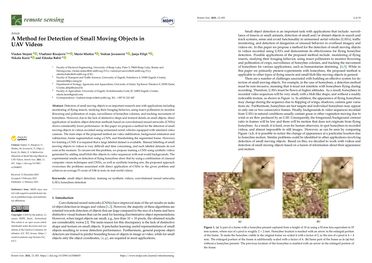A Method for Detection of Small Moving Objects in UAV Videos
Detection of small moving objects is an important research area with applications including monitoring of flying insects, studying their foraging behavior, using insect pollinators to monitor flowering and pollination of crops, surveillance of honeybee colonies, and tracking movement of honeybees. However, due to the lack of distinctive shape and textural details on small objects, direct application of modern object detection methods based on convolutional neural networks (CNNs) shows considerably lower performance. In this paper we propose a method for the detection of small moving objects in videos recorded using unmanned aerial vehicles equipped with standard video cameras. The main steps of the proposed method are video stabilization, background estimation and subtraction, frame segmentation using a CNN, and thresholding the segmented frame. However, for training a CNN it is required that a large labeled dataset is available. Manual labelling of small moving objects in videos is very difficult and time consuming, and such labeled datasets do not exist at the moment. To circumvent this problem, we propose training a CNN using synthetic videos generated by adding small blob-like objects to video sequences with real-world backgrounds. The experimental results on detection of flying honeybees show that by using a combination of classical computer vision techniques and CNNs, as well as synthetic training sets, the proposed approach overcomes the problems associated with direct application of CNNs to the given problem and achieves an average F1-score of 0.86 in tests on real-world videos.
PDF AbstractDatasets
Introduced in the Paper:
Bee4Exp Honeybee DetectionResults from the Paper
 Ranked #1 on
Small Object Detection
on Bee4Exp Honeybee Detection
(using extra training data)
Ranked #1 on
Small Object Detection
on Bee4Exp Honeybee Detection
(using extra training data)
| Task | Dataset | Model | Metric Name | Metric Value | Global Rank | Uses Extra Training Data |
Benchmark |
|---|---|---|---|---|---|---|---|
| Small Object Detection | Bee4Exp Honeybee Detection | BeeDetector | Average F1 | 0.86 | # 1 |




